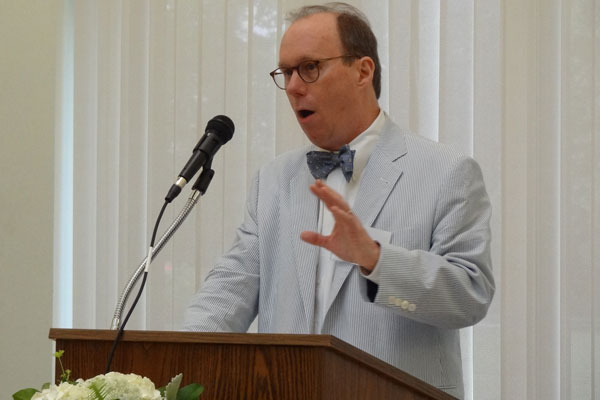Portsmouth Institute 2013 Conference: “Catholicism and the American Experience,” Day 1, Roger Kimball
Being a mainstay in the intellectual salon of the American Right, it isn’t surprising that Roger Kimball cast quite a different shadow than did Peter Steinfels, whom he followed on the first day of this year’s Portsmouth Institute conference, June 7. Kimball publishes the New Criterion and opines regularly online at the libertarian-conservative PJ Media site. He was also a speaker at the very first Portsmouth Institute conference, in 2009, remembering William F. Buckley.
This time around, Mr. Kimball complemented his characteristic bow tie with a seersucker suit, and his talk was on “Is There Such a Thing as Catholic Art?”
However, as if he had intuitively understood the thread that the other speakers would weave throughout the weekend, his topic was less a definition of what art might mean within Catholicism than how art, as currently defined, broke from its own traditions, which were irrefutably interwoven with Christianity. If Peter Steinfels is “uneasy, uneasy, uneasy” with the impression that his coreligionists are positioning their faith as adversarial to modern life, Roger Kimball presents the art world as the hollow model of a tradition that takes adversarial posturing to its absurd conclusion.
“In large precincts of the art world today, art is oppositional or it is nothing,” he says. Furthermore, it is that way precisely because it remains a superficial medium for the sensation of spirituality. Modern art still contrasts itself with ordinary life by declaring modern life to be meaningless, but the contrast is in the declaration, not the lack of meaning.
The image that Kimball paints is of an illusion — a scam — by which artists make their own lives meaningful by making their own superficial and sparsely imaginative statements salable on the art market. (Perhaps a culture of reality television and online biographical denudement can be interpreted as a longing of the masses for a mere sip of such meaning.)
A true conservative, he traces that tendency all the way back to the development of visual perspective in the visual arts, which made the artist’s point of view more important than it had been. In the intellectual arts, philosophy moved to make people the authors of reality.
The underlying problem is spiritual, to be sure, but even within the context of art qua art, Kimball laments the loss of beauty. As he puts it, beauty begets an aesthetic experience, but aesthetics needs import… meaning. A wail of “I am here!” is not likely to be beautiful, and if it is not, then the affirmation that the artist seeks is apt to be met with replies of “Who cares?” or “I wish you were not.”
Of course, status-conscious insecurettentes may periodically save the artists by seeking meaning in the cultivation of a high tolerance for visual gobbledegook. The latest in thing will bring a swell of dollars, which have become in a sense the paper-mâché of meaning in the modern world.
By way of a postscript, an interesting point arose between the lines when Steinfels stood to ask Kimball a question after the speech. Why, he asked, are the visual arts uniquely inclined toward antagonism, particularly antagonism against religious faith?
Kimball noted the role of visual arts in our society, including the hit or miss divide between the starving artist and the multimillionaire artiste. “In music,” he said, aggressive antagonism would mostly be “boring.”
The particular media of the arts may play a greater role than that, though. Visual art is fast, and the initial taste of its statement can be cut off with the turn of the head. The shock is like a sour candy, to be savored for a moment and then washed away with something more corporeally satisfying. Music, as Kimball suggests, is temporal; during the repetition necessary to run out the clock, a shock for a shock’s sake loses its resonance, as would a painting past which one walks many times a day.
What’s interesting is that literature has quite a different role, mainly because it trades in stories. And good stories, the kind that have any aesthetic appeal at all, have meaning. That is why (I’d venture to propose) good books and good story-driven movies, plays, and shows tend to have conservative themes, no matter how progressive or transgressive the authors and producers imagine themselves to be.




